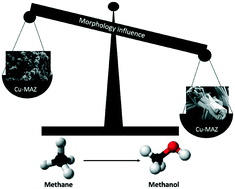The influence of zeolite morphology on the conversion of methane to methanol on copper-exchanged omega zeolite (MAZ)†
Abstract
Methane is often flared due to the heavy economic burden of transportation, particularly at rural petroleum extraction sites. Directly converting methane to methanol is possible through a stepwise process with copper-exchanged zeolites. Factors affecting this conversion are not yet fully understood. Omega zeolite (MAZ) can yield 197 μmol per gram-zeolite, the highest reported thus far. Here we show that the synthesis and resulting morphology of the zeolite play an enormous role in the yield of methanol. High yields are only achieved when the zeolite has a longer stick-like bundled morphology (2–4 μm by 100 nm). When the zeolite forms small spherulitic aggregates, the methanol yield is severely diminished (60–97 μmol-methanol per gram-zeolite). This difference originates from minute changes in the synthesis procedure, emphasizing the extreme sensitivity of zeolite properties towards synthesis conditions. This work shows that selecting a parent zeolite is crucial and is an opportunity for process optimization to achieve high and industrially-relevant methanol yields.



 Please wait while we load your content...
Please wait while we load your content...